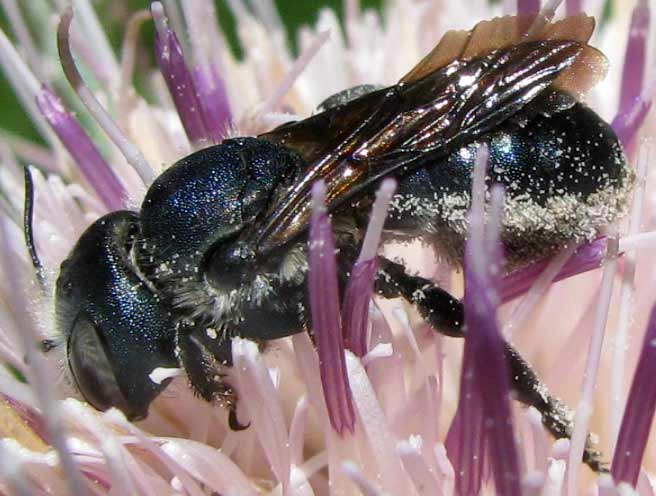Excerpts from Jim Conrad's
Naturalist Newsletter

from the April 22, 2012 Newsletter issued from the woods of the Loess Hill Region a few miles east of Natchez, Mississippi, USA
MASON BEES ON THISTLES
Several pink-flowered Bull Thistles inhabit the infrequently bush-hogged lawn/orchard in front of the trailer. You and see our Bull Thistle page at http://www.backyardnature.net/n/h/bullthst.htm.
Though in many places it's illegal to allow Bull Thistles to stand on your land -- their very spiny parts can ruin grazing livestock's mouths and stomachs -- every day I visit each of our flowering thistles because their perfumy blossoms attract many pollinators. That's where I found the bee shown above.
Two bees of the same species worked together and when I saw them my heart skipped a beat, because they were collecting pollen not in "pollen baskets" on their hind legs, but on the hairy bottoms of their abdomens. That's what the leafcutter bees we looked at a couple of weeks ago in the Yucatan did. Were these leafcutters, too?
Volunteer identifier Bea in Ontario quickly figured them out, and an expert at BugGuide.net confirmed it, that what we had was a mason bee, OSMIA CHALYBEA. Bea points out that mason bees belong to the same bee family, the Megachilidae, as our leafcutters, so they're closely related.
Why haven't I noticed mason bees before? Maybe I was just blinded by my ignorance, or maybe they were less common in the past. For, we know that honeybees are having a hard time in the US. Honeybees are invasive, European species, so when honeybees were introduced into North America they must have displaced many native pollinator species. Maybe now that honeybees are suffering a population collapse, the natives are returning. I don't know that that's happening, but it makes sense.
In fact, some people already are promoting, and selling, mason bees as pollinators for orchards and fields where honeybees have disappeared, as you can see at http://osmia.com/.